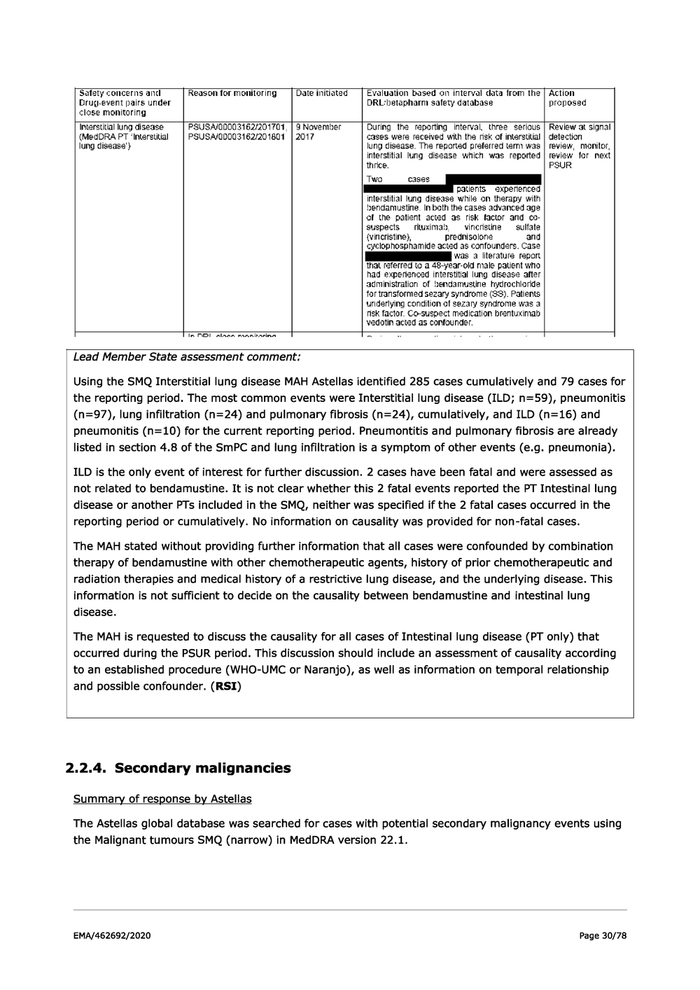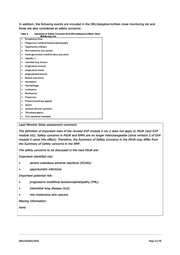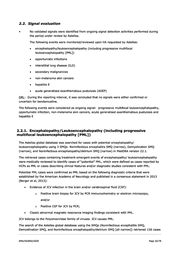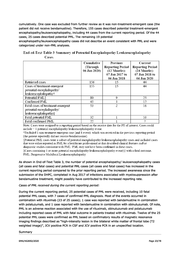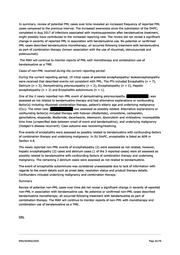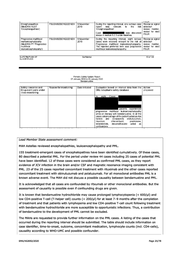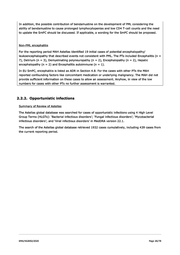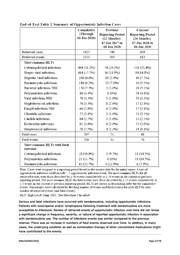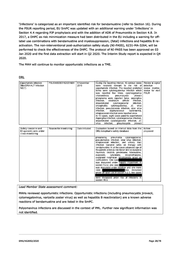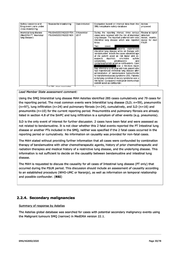R - bendamustine hydrochloride-PSUSA-3162-202001-PRAC AR_BfArM
In addition, the following events are included in the DRL/betapharm/Altan close monitoring list and these are also considered as safety concerns: Table 4 Summary cf Safety Concerms from DRUbetapharm'Akarn Close Monitoring List Erserphalopachies Frogressve mulsfosal leuksenzephalopathiyr Crpotunistic infecbor Ker-melanoma skin Gansers Acute generaliseed exantheratous pusuksis Hepatitis = Interstitial lung disease Anaphiylactic reacien Zraphylactic shock Zraphylactoid reason Bullsus exan-hema Haermelysis Haererhage Leukopenia Heufopenia Freurronis Freurronia pritan abpical Sepsis ZevensJohnson syndrome Thrombsoarnopenia Toxiz epidermal nesrolysis Lead Member State assessment comment: The definition of important risks of the revised GVP module V rev.2 does not apply to PSUR (and GVP module VII). Safety concerns in PSUR and RMPs are no longer interchangeable (since revision 2 of GVP module V came into effect). Therefore, the Summary of Safety Concerns in the PSUR may differ from the Summary of Safety concerns in the RMP. The safety concerns to be discussed in the next PSUR are: Important identified risk: . severe cutaneous adverse reactions (SCARSs) . opportunistic infections Important potential risk: . progressive multifocal leukoencephalopathy (PML) . interstitial lung disease (ILD) . non-melanoma skin cancers Missing information: none EMA/462692/2020 Page 21/78
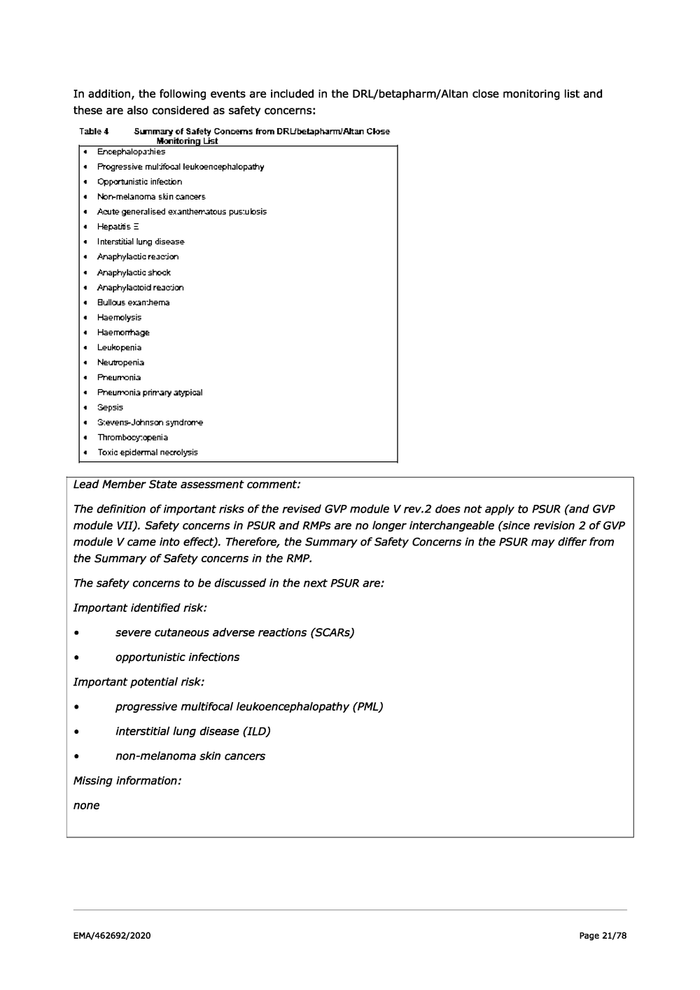
2.2. Signal evaluation . No validated signals were identified from ongoing signal detection activities performed during the period under review by Astellas. The following events were monitored/reviewed upon HA requested by Astellas: e encephalopathy/leukoencephalopathy (including progressive multifocal leukoencephalopathy [PML]) e _opportunistic infections «e interstitial lung disease (ILD) e secondary malignancies «e _non-melanoma skin cancers e hepatitis E «e acute generalized exanthematous pustulosis (AGEP) DRL: During the reporting interval, it was concluded that no signals were either confirmed or uncertain for bendamustine. The following events were considered as ongoing signal: progressive multifocal leukoencephalopathy, opportunistic infection, non-melanoma skin cancers, acute generalised exanthematous pustulosis and hepatitis E 2.2.1. Encephalopathy/Leukoencephalopathy (including progressive multifocal leukoencephalopathy [PML]) The Astellas global database was searched for cases with potential encephalopathy/ leukoencephalopathy using 3 SMQs: Noninfectious encephalitis SMQ (narrow), Demyelination SMQ (narrow), and Noninfectious encephalopathy/delirium SMQ (narrow) in MedDRA version 22.1. The retrieved cases containing treatment-emergent events of encephalopathy/ leukoencephalopathy were medically reviewed to identify cases of “potential” PML, which were defined as cases reported by HCPs as PML or cases describing clinical features and/or diagnostic studies consistent with PML. Potential PML cases were confirmed as PML based on the following diagnostic criteria that were established by the American Academy of Neurology and published in a consensus statement in 2013 [Berger et al, 2013]: e Evidence of JCV infection in the brain and/or cerebrospinal fluid (CSF): o Positive brain biopsy for JCV by PCR immunochemistry or electron microscopy, and/or o Positive CSF for JCV by PCR; e Classic abnormal magnetic resonance imaging findings consistent with PML. JCV belongs to the Polyomaviridae family of viruses. JCV causes PML. The search of the Astellas global database using the SMQs (Noninfectious encephalitis SMQ, Demyelination SMQ, and Noninfectious encephalopathy/delirium SMQ [all narrow]) retrieved 156 cases EMA/462692/2020 Page 22/78
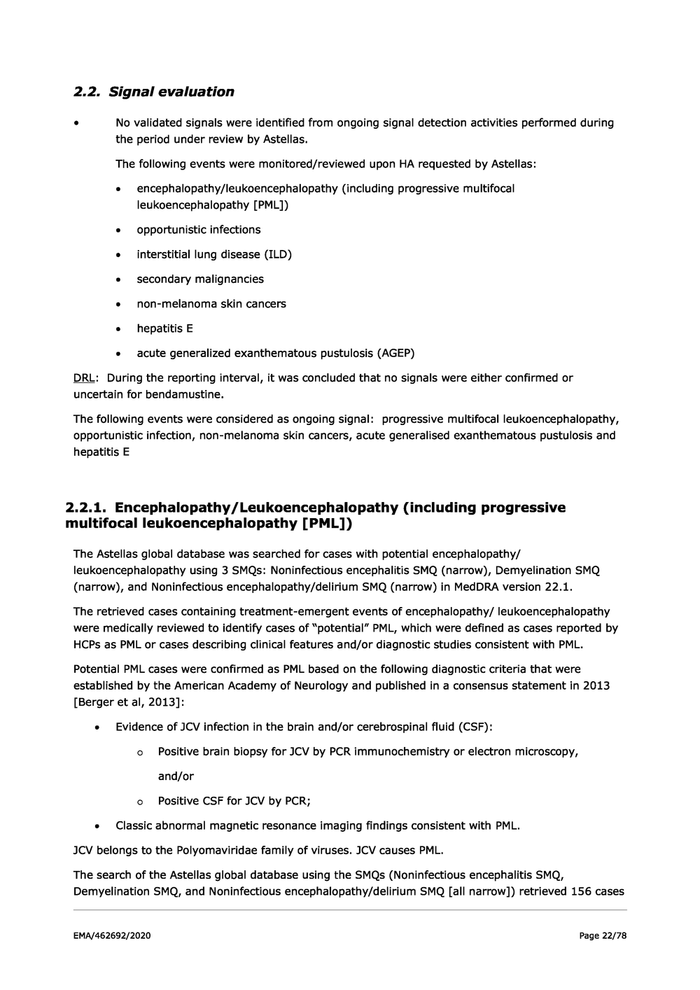
cumulatively. One case was excluded from further review as it was non-treatment-emergent case (the
patient did not receive bendamustine). Therefore, 155 cases described potential treatment-emergent
encephalopathy/leukoencephalopathy, including 44 cases from the current reporting period. Of the 44
cases, 25 cases described potential PML. The remaining 19 potential
encephalopathy/leukoencephalopathy cases did not describe an event consistent with PML and were
categorized under non-PML analyses.
End-of-Text Table 3 Summary of Potential Encephalepathy:Leukoencephalopathy
Uases
Cumulative Preyriaus Current
{Throush | Reporting Period | Reporting Period
6a Jan 2020) {12 3lanths}: (24 A Tantlıs}:
07 Jan 2017 to 07 Jan 2015 to
04 Jan 3018 4 Jan 3620
Retrieved cases 156 15 44
Cases of treatiment-emergent 155 15 44
potential encephalopathy:
leukoencephalopathyt
Potential PMLY 80 9 25
Confirmed PWIL 45 ä 1?
Fr
l
Fatal cases of treatment-emergent 53
potential encephalopathy.
leukoencephalopathy$
Fatal potential PML 32
Fatal confirmed PML 7?
Note: Cases were assigned to a reporting period based on the receive date for the PT of interest. Cases could
include 1 potential encephalopatiyileuksencephalopathiy event.
Exeluded 1 non-treatment emergent case (and 1 event). which was received ın the previous reporting period
(the patient reportedly did not receive bendamustine).
7Potential PML cases were a subset of potential encephalopattiyrleukosucephalopathry cases and included cases
that were either reported as PML by a healthcare professional or that described clinical features and’or
diasnostie studies consistent with PML: PML may nor have been canfirmed in these cases.
Slases containing ] or mare potential encephalopathyrleukoencephalapathy, event’s) wirh a fatal outcome.
PML: Progressive Multifocal Leukoencephalopatliy
As shown in End-of-Text Table 3, the number of potential encephalopathy/ leukoencephalopathy cases
(all cases and fatal cases) and potential PML cases (all cases and fatal cases) has increased in the
current reporting period compared to the prior reporting period. The increased awareness since the
submission of the DHPC, completed in Aug 2017 of infections associated with myelosuppression after
bendamustine treatment, might possibly have contributed to the increased reporting rate.
Cases of PML received during the current reporting period:
During the current reporting period, 25 potential cases of PML were received, including 10 fatal
potential PML cases, with 7 cases of confirmed PML diagnosis. Most of the events occurred in
combination with rituximab (23 of 25 cases); 1 case was reported with bendamustine in combination
with polatuzumab, and 1 case reported with bendamustine in combination with obinutuzumab. Of note,
PML is an adverse reaction associated with the use of rituximab, obinutuzumab and polatuzumab
including reported cases of PML with fatal outcome in patients treated with rituximab. Twelve of the 25
potential PML cases were confirmed as PML based on confirmatory results of magnetic resonance
imaging findings described as “high-intensity lesion in the bilateral white matter of frontal lobe (T2
weighted image)”, JCV positive PCR in CSF and JCV positive PCR in an unspecified location.
Summary
EMA/462692/2020 Page 23/78
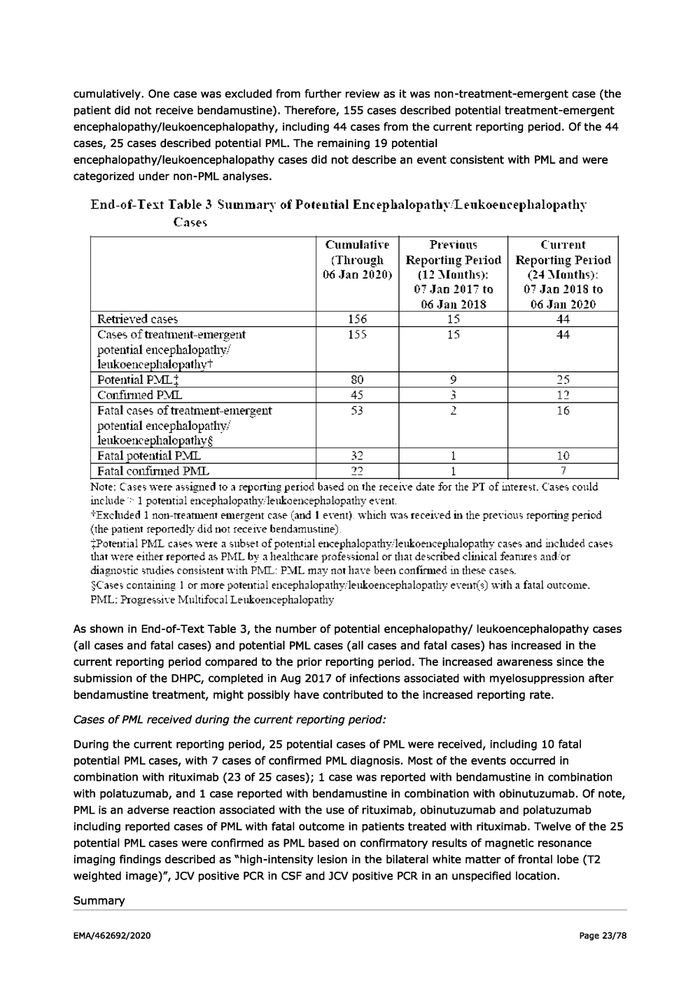
In summary, review of potential PML cases over time revealed an increased frequency of reported PML cases compared to the previous interval. The increased awareness since the submission of the DHPC, completed in Aug 2017 of infections associated with myelosuppression after bendamustine treatment, might possibly have contributed to the increased reporting rate. The review did not reveal a significant change in severity of reported PML in association with bendamustine use. No potential or confirmed PML cases described bendamustine monotherapy; all occurred following treatment with bendamustine as part of combination therapy (known association with the use of rituximab, obinutuzumab and polatuzumab). The MAH will continue to monitor reports of PML with monotherapy and combination use of bendamustine as a TME. Cases of non-PML received during the current reporting period: During the current reporting period, 19 initial cases of potential encephalopathy/ leukoencephalopathy were received that described events not consistent with PML. The PTs included Encephalitis (n = 7), Delirium (n = 3), Demyelinating polyneuropathy (n = 2), Encephalopathy (n = 2), Hepatic encephalopathy (n = 2) and Encephalitis autoimmune (n = 1). One of the 2 newly reported non-PML event of demyelinating polyneuropathy ER) was assessed as not related to bendamustine therapy and had alternative explanations or confounding factor(s) including rituximab combination therapy, patient’s elderly age and underlying malignancy (CLL). The other case EEE was assessed as possibly related. Alternative explanations or confounding factor(s) included therapy with holoxan (ifosfamide), vinorelbine, carboplatin, gemcitabine, etoposide, ifosfamide, dacarbazine, bleomycin, doxorubicin and vinblastine; incompatible time lines (unspecified date between onset of event and bendamustine); and underlying malignancy (Hodgkin’s disease recurrent). Case outcome was recovering/resolving. Five events of encephalitis were assessed as possibly related to bendamustine with confounding factors of combination therapy and underlying malignancy. In EU SmPC, encephalitis is listed as ADR in Section 4.8. The newly reported non-PML events of encephalopathy (2) were assessed as not related; however, hepatic encephalopathy (2) cases and delirium cases (1 of the 3 reported cases) were all assessed as possibly related to bendamustine with confounding factors of combination therapy and underlying malignancy. The remaining 2 delirium cases were assessed as not related to bendamustine. The event of encephalitis autoimmune was considered unassessable due to lack of information with regards to the event details such as onset date, resolution status and product therapy details. Confounders included underlying malignancy and combination therapy. Summary Review of potential non-PML cases over time did not reveal a significant change in severity of reported non-PML in association with bendamustine use. No potential or confirmed non-PML cases described bendamustine monotherapy; all occurred following treatment with bendamustine as part of combination therapy. The MAH will continue to monitor reports of non-PML with monotherapy and combination use of bendamustine as a TME. EMA/462692/2020 Page 24/78
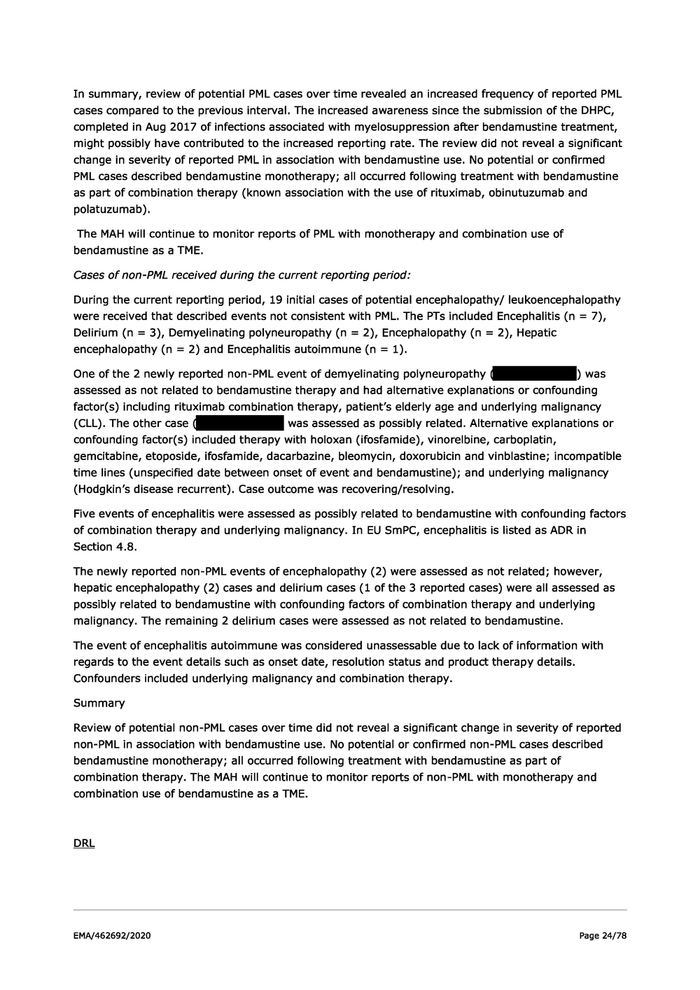
Fouym Encephaälcpathies FSUSA/00003162'201301 | 9 Nowernber During the reporting interwal, one serious case | Review at signal (MedbRA HLEST 2013 report was relevarı to the risk | detection 'Encephalopathies') ’Encephalcpathies'. review, monitor, Case was discussed BSUR far next above in section 5.2.3 under fatalities. Frogrsssive multifocal FSUSA/00003162'201301 | 9 Nowernber During the reporting interwal, sight serious | Review at signal leuksencephalopathy 2013 c3S85 were received relevant to the risk of | detection (MedDRA FT Progressive Progressive multifgcal leukgencsphalcpathy. | review, monitor, multifocal The reported preferred term was progressive | review for next leuksencephalepathy'} multifocal leuksencephalapathy. FSUR EU-FORM-PU-CH ET Sonidential Elof 124 EJ-SGP-PY-C05 Periodic Safety Update Report 07 January 2015 to 06 January 2020 Bendamustine Safety concerns and Erug-eyent pairs under close monitoring Reason for monitoring Date initiated Evaluation based on interval data from the DRL’betapharnı safety database patients experienced progressive multifocal leukaentephalopathy while on therapy with bendamustine. In all ine c3585 advanced age ofthe patient acted as risk factors and co-susperis chinutuzumah, ntyximal, chlerambueil, prednisone, lenalidemide, dexamsthasorne acted 35 confsunders. Action praposed Lead Member State assessment comment: MAH Astellas reviewed encephalopathies, leukoencephalopathy and PML. 155 treatment-emergent cases of encephalopathies have been identified cumulatively. Of these cases, 80 described a potential PML. For the period under review 44 cases including 25 cases of potential PML have been identified. 12 of these cases were considered as confirmed PML cases, as they report evidence of JCV infection in the brain and/or CSF and magnetic resonance imaging consistent with PML. 23 of the 25 cases reported concomitant treatment with rituximab and the other cases reported concomitant treatment with obinutuzumab and polatuzumab. For all monoclonal antibodies PML is a known adverse event. The MAH did not discuss a possible causality between bendamustine and PML. It is acknowledged that all cases are confounded by ritxumab or other monoclonal antibodies. But the assessment of causality is possible even if confounding drugs are given. It is known that bendamustine hydrochloride may cause prolonged Iymphocytopenia (< 600/ul) and low CD4-positive T-cell (T-helper cell) counts (< 200/ul) for at least 7-9 months after the completion of treatment and that patients with Iymphopenia and low CD4-positive T-cell count following treatment with bendamustine hydrochloride are more susceptible to opportunistic infections. Thus, a contribution of bendamustine to the development of PML cannot be excluded. The MAHSs are requested to provide further information on the PML cases. A listing of the cases that occurred during the reporting interval should be submitted. The table should include information on case identifier, time-to-onset, outcome, concomitant medication, Iymphocyte counts (incl. CD4-cells), causality according to WHO-UMC and possible confounder. EMA/462692/2020 Page 25/78

In addition, the possible contribution of bendamustine on the development of PML considering the ability of bendamustine to cause prolonged Iymphocytopenias and low CD4 T-cell counts and the need to update the SmPC should be discussed. If applicable, a wording for the SmPC should be proposed. Non-PML encephalitis For the reporting period MAH Astellas identified 19 initial cases of potential encephalopathy/ leukoencephalopathy that described events not consistent with PML. The PTs included Encephalitis (n = 7), Delirium (n = 3), Demyelinating polyneuropathy (n = 2), Encephalopathy (n = 2), Hepatic encephalopathy (n = 2) and Encephalitis autoimmune (n = 1). In EU SmPC, encephalitis is listed as ADR in Section 4.8. For the cases with other PTs the MAH reported confounding factors like concomitant medication or underlying malignancy. The MAH did not provide sufficient information on these cases to allow an assessment. Anyhow, in view of the low numbers for cases with other PTs no further assessment is warranted. 2.2.2. Opportunistic infections Summary of Review of Astellas The Astellas global database was searched for cases of opportunistic infections using 4 High Level Group Terms (HLGTs): ‘Bacterial infectious disorders’; ‘Fungal infectious disorders’; ‘Mycobacterial infectious disorders’; and ‘Viral infectious disorders’ in MedDRA version 22.1. The search of the Astellas global database retrieved 1932 cases cumulatively, including 439 cases from the current reporting period. EMA/462692/2020 Page 26/78
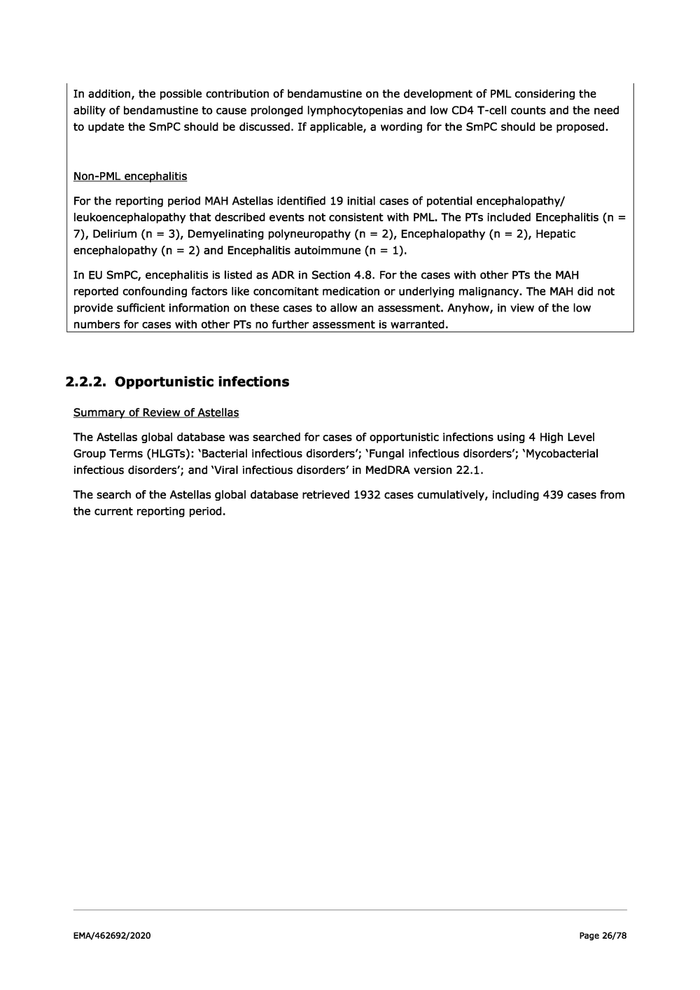
End-of-Text Table 2 Summary of Opportunistic Infection Cases
Current
Reporting Period
(24 \lonths}:
Prerious
Reporting Period
{12 %lLanths}:
07 Jan 2017 ta 07 Jan 2018 to
06 Jan 3615 06 Tan 2020
Retrieved cases 249 439
Retrieved events 304 613
\Iost common HLTs
Crtomegaloriral mfections
Cumulatire
{Throush
Ga Jan 2020)
494 (21.2%)
414 (17.7%)
108 (4.56%)
74 (24.3%)
36 (11.9%)
18 (5.9%)
156 (25.4%)
91014.8%)
46. (7.53%)
Heıpes vıral infections
Hepatitis vıral infections
Pneumoeystis ınfections
Bacterial infections NEC
Polyomavırıs infections
Yıral infections NEC
Staplmylococcal infections
Fingal infections NEC
Clostridia infections
Candida ınfections
Escherichia infections
Streptococral infections
144 (6.2%)
176 (7,5%)
80 (3.4%)
78 (3.3%)
76 (3.3%)
66 (2.83%)
72 (3.1%)
64 (2.17%)
61 (2.56%)
58 (2,5%)
73 (7.65%)
3 (1.0%)
0 (0%)
1.6%)
2,6%)
5 (2.0%)
1.0%)
1.6%)
5 (2.0%)
34. (5.53%)
31 (5.1%)
28 (4,6%)
20. (3.3%)
17 (2.8%)
17.(7.8%)
13 (7.1%)
13 (2.1%)
1? (2,0%)
11 (1.83%)
Fatal cases
Fatal events
Alost common HLT: with fatal
oufcome
18.(10.0%)
21(11.7%) 0 (0%)
3 (9.7%) 11 (14.596)
11 (14.596)
6 (7.9%)
Cytomegalovıral infections
Polyomavınıs infections
41(22.7%) 4(12.9%)
Note: Cases were a5512ned to a reporting period based on the receive date for the mal report. Cases of
opportunistic infection could include = 1 oppormunistic nfection event. The most common HLT;: far all
retrieved events were those described by = 40 events cumulatıveiy or = 10 events ın the current or previous
reporting period. The most common HLT: for fatal events were those described by = 15 events cumulativelv or
= 5 events in the curtent or previous reporting period. HLTs are shown in descending order for the cumulative
events. Percentages were calculated by disiding number of events {and fatal events) for each HLT by total
number of rermeved events (and fatal events).
HLT: High Level Term: NET: Not Elsewhere Classified
Pneumocystis infections
Serious and fatal infections have occurred with bendamustine, including opportunistic infections.
Patients with neutropenia and/or Iymphopenia following treatment with bendamustine are more
susceptible to infections. Review of retrieved events of opportunistic infection over time did not reveal
a significant change in frequency, severity, or nature of reported opportunistic infection in association
with bendamustine use. The number of infections events was similar compared to the previous
interval. There was an increase in numbers of fatal events observed over time. In addition, in many
cases, the underlying condition as well as combination therapy of other concomitant medications might
have contributed to the events.
EMA/462692/2020 Page 27/78
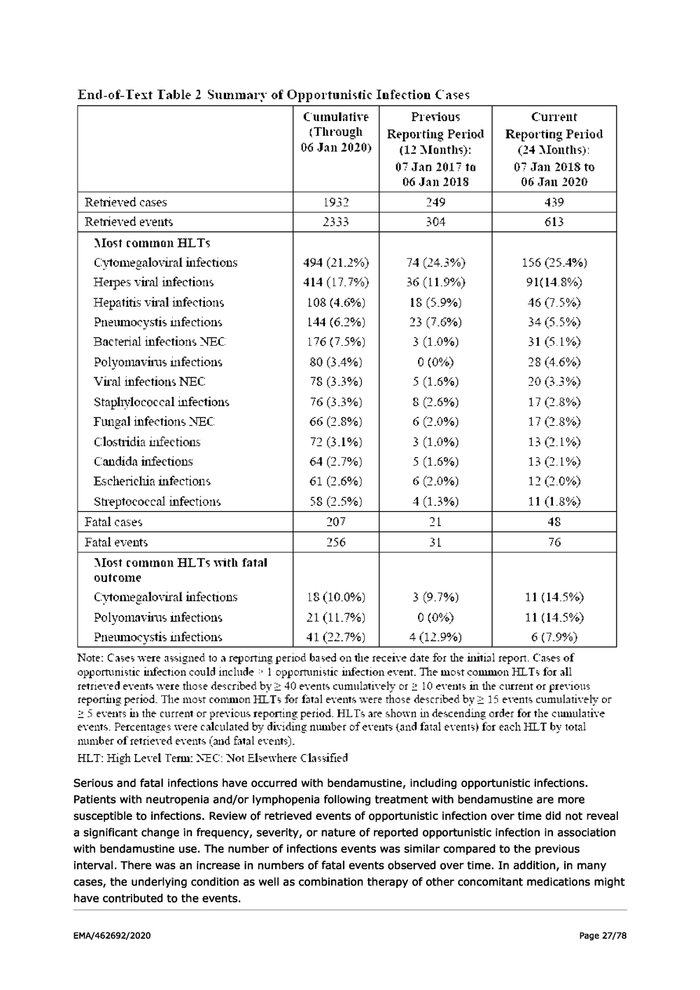
‘Infections’ is categorized as an important identified risk for bendamustine (refer to Section 16). During the PSUR reporting period, EU SmPC was updated with an additional warning under ‘Infections’ in Section 4.4 regarding PJP prophylaxis and with the addition of ADR of Pneumonitis in Section 4.8. In 2017, a DHPC as risk minimization measure had been distributed in the EU including a warning for off- label use combinations with bendamustine and myelosuppression, (fatal) infections and hepatitis B re- activation. The non-interventional post-authorization safety study (NI-PASS), 6231-MA-3264, will be performed to check the effectiveness of the DHPC. The protocol of NI-PASS has been approved on 03 Jan 2020 and the first data extraction will start in Q2 2020. The Interim Study report is expected in Q4 2020. The MAH will continue to monitor opportunistic infections as a TME. Prpartunistic infectiori PSUSAM0D003152/201801 | 9 November During the reporting interval, 13 serious cases | Review at signal (MedDRA HLT 'Infection 2013 were received relevant to the risk ofl| detection NEC” opportunistic infection. The reported preferred | review, monitor, terms were cytomegalovirus infection which | review for next was reported fwe times, cylomegalovirus | PSUR therioretinitis, pneumacysis jirovecii pneumcnia were reported twice, aspergillus infection, <clestridium Jifieile infection, disseminated cytoniegaloviral irfection, encephalitis cytomegalevius, JE winus infection, pseudamenas infection, slow virus infection, staphylaceccal hacteraemia, streptacsecal infectior were reported once. In 13 cases, eight cases patients experierced Aspergillus infection, cylomegalowinus infection, disseminated cytomegaloviral infection, JG vius __infectior Pneumocystis irovecii Safety concerns and Reason for monitoring Date initiated Evaluation based on interral data from the | Action Drug-event pairs under DRL:betapharnı safety database proposed <lose monitoring Preumenia, pneumonia cylomegalaviral, Pseudomonas infection, siow virus infection, streptaceecal infeclien, and unnary tracl infection bacterial while on therapy with hendamustine. In allthe cases advanced age of the patient acted as risk factor and co-suspects ntuximahb, ibrutinib, prednisone, fotemustine, stoposide, <ytarabineg, dexamethasore, oxaliplatin melphalan, lenalidonmide acted_ as zonfeunders. One case was discussed under hepalic impairment irn section 5.2.2, one case was discussed under fatalities and one more case was discussed under off label use.in section 5.2.3, Wo ca505 were discussed under risk of infections ir section 15.3. Lead Member State assessment comment: MAHSs reviewed opportunistic infections. Opportunistic infections (including pneumocystis jirovecii, cytomegalovirus, varizella zoster virus) as well as hepatitis B reactiviation) are a known adverse reactions of bendamustine and are listed in the SmPC. Polyomavirus infections are discussed in the context of PML. Further new significant information was not identified. EMA/462692/2020 Page 28/78
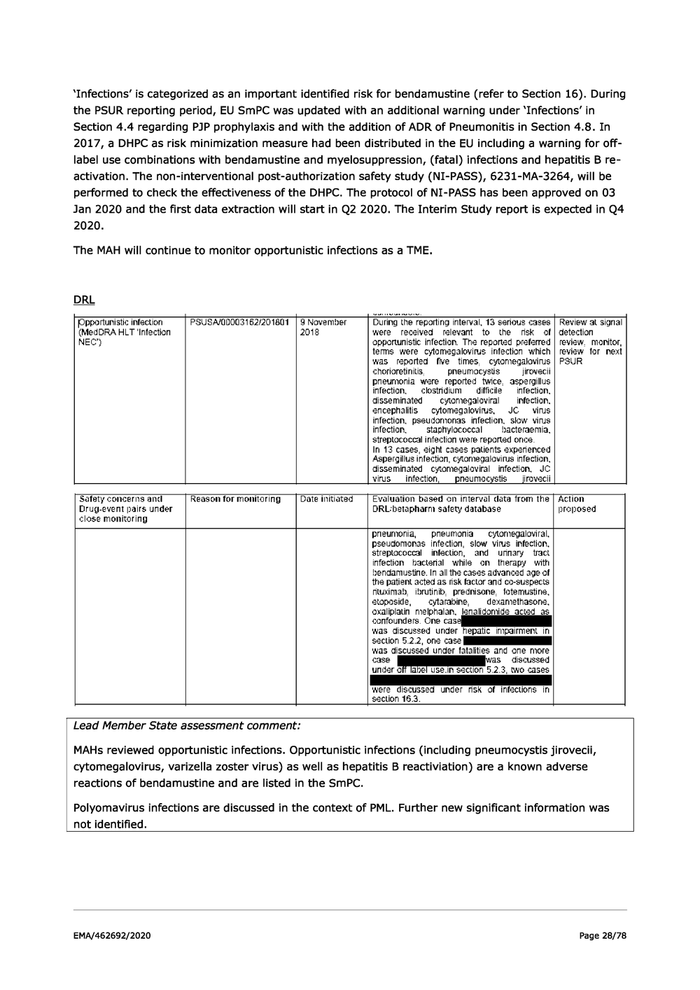
2.2.3. Interstitial lung disease (ILD) Summary of response by Astellas The Astellas global database was searched for cases of ILD and pneumonitis using Interstitial lung disease (SMQ) [broad] in MedDRA version 22.1. The search of the Astellas global database retrieved 285 cases cumulatively, including 49 cases from the current reporting period. End-of-Text Table 4 Summary of Interstitial Lung Disease Cases Cumulative Previous Current (Throngh | Reporting Period | Reporting Period 06 Jan 2020) (12 Alontlıs): (24 Alonths): 07 Jan 2017 to 07 Jan 2018 to 06 Jan 2018 06 Jan 2020 Retrieved cases 285 24 49 lost common PTs Interstitial lung disease 59 10 18 Pneumonitis 97 6 10 Pulmonary fibrosis 18 2 0 Lung inältration 24 2 l Pulmonary alveolar haemorrhage 3 0 2 Pulmonary toxicity 8 3 4 Fatal cases 52 5 > %Iost common PTs with fatal outcome Interstitial lung disease 4 1 2 Pulmonary toxıcity l 1 l In authority cases EEE a) N, ILD with fatal outcome was reported, and assessed as not related to bendamustine. Other suspect drugs included rituximab. In another case from published literature, EEE, the fatal event Death was reported (event was unassessable due to lack of information concerning the event details such as exact cause of death and lack of autopsy findings). Summary During the reporting interval, the search retrieved 49 cases of ILD were received including 16 cases of PT Interstitial lung disease. Two fatal events were reported in Interstitial lung disease (SMQ) [broad]; assessed as not related to bendamustine. Confounders for all cases included combination therapy of bendamustine with other chemotherapeutic agents, history of prior chemotherapeutic and radiation therapies and medical history of a restrictive lung disease, and the underlying disease. Pulmonary fibrosis is included in both EU SmPC and CCDS as ADR in Section 4.8. The Section 4.8 of EU SmPC includes the ADRs of pneumonitis and pulmonary alveolar hemorrhage. The MAH will continue to monitor ILD and pneumonitis as a TME. EMA/462692/2020 Page 29/78
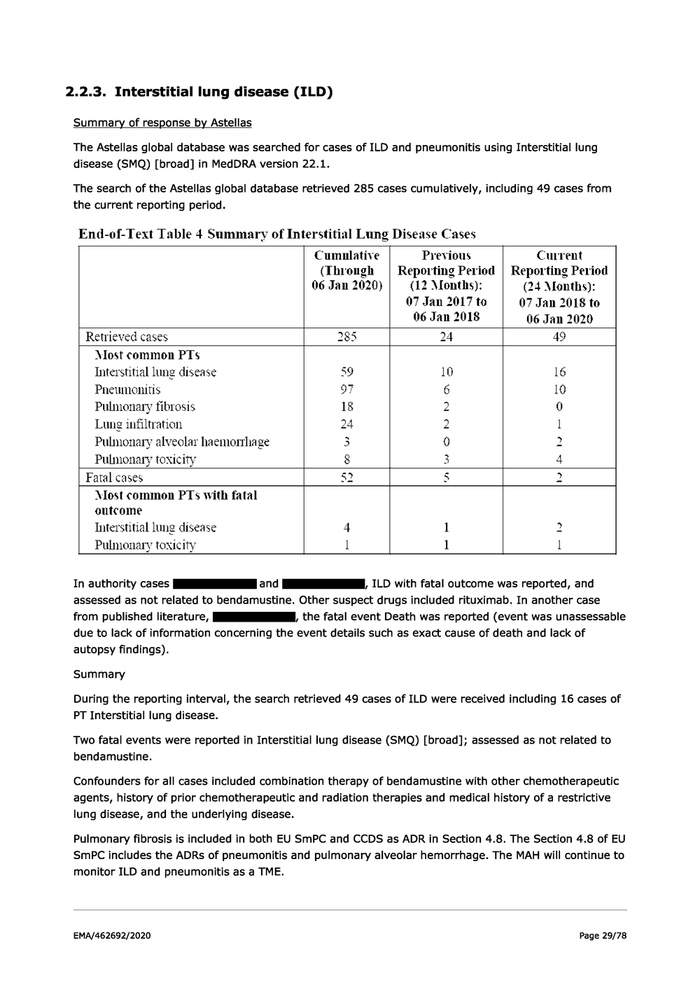
Safety concerns and Reason for monitoring Date initiated Evaluation based on interyal data from the | Action
Drug-event pairs under DRL:betapharm safety database praposed
close monitöring
Interstitial lung disease FSUSA00003162/201701. | 9 November During the reporting interwal, Ihree serious | Review at signal
(MedDRA PT “Interstitial PFSUSAr00003162/201801 | 2017 c3ses were received with the risk of interstitial | detection
lung dissase'} lung disease. The reported preferred tem was | review, monitor,
interstitial lung disease which was reported | review for next
thrice. PSUR
Two cases
patients experienced
interstitial [ung disease while on therapy with
hendamustine. In both the cases advanced age
of the patient acted 38 risk factor and c0-
syspecis ntuximal, vinenstine — sulfate
{wincristine}, prednisolone and
<yelophssphamide acted as confounders. Case
was 3 literature report
that referred to a 48-year-old male patient who
had experienced interstitial lung disease after
administration of bendamustine hydrochloride
for transformed sezary syndrome ($5). Patients
undertying condition of sezary syndrome was a
risk factor. Co-Suspect medication hrentuxinah
vedotin acted a5 confounder.
Ir MD Alaan mariarimn -
Lead Member State assessment comment:
Using the SMQ Interstitial lung disease MAH Astellas identified 285 cases cumulatively and 79 cases for
the reporting period. The most common events were Interstitial lung disease (ILD; n=59), pneumonitis
(n=97), lung infiltration (n=24) and pulmonary fibrosis (n=24), cumulatively, and ILD (n=16) and
pneumonitis (n=10) for the current reporting period. Pneumontitis and pulmonary fibrosis are already
listed in section 4.8 of the SmPC and lung infiltration is a symptom of other events (e.g. pneumonia).
ILD is the only event of interest for further discussion. 2 cases have been fatal and were assessed as
not related to bendamustine. It is not clear whether this 2 fatal events reported the PT Intestinal lung
disease or another PTs included in the SMQ, neither was specified ifthe 2 fatal cases occurred in the
reporting period or cumulatively. No information on causality was provided for non-fatal cases.
The MAH stated without providing further information that all cases were confounded by combination
therapy of bendamustine with other chemotherapeutic agents, history of prior chemotherapeutic and
radiation therapies and medical history of a restrictive lung disease, and the underlying disease. This
information is not sufficient to decide on the causality between bendamustine and intestinal lung
disease.
The MAH is requested to discuss the causality for all cases of Intestinal lung disease (PT only) that
occurred during the PSUR period. This discussion should include an assessment of causality according
to an established procedure (WHO-UMC or Naranjo), as well as information on temporal relationship
and possible confounder. (RSI)
2.2.4. Secondary malignancies
Summary of response by Astellas
The Astellas global database was searched for cases with potential secondary malignancy events using
the Malignant tumours SMQ (narrow) in MedDRA version 22.1.
EMA/462692/2020 Page 30/78
